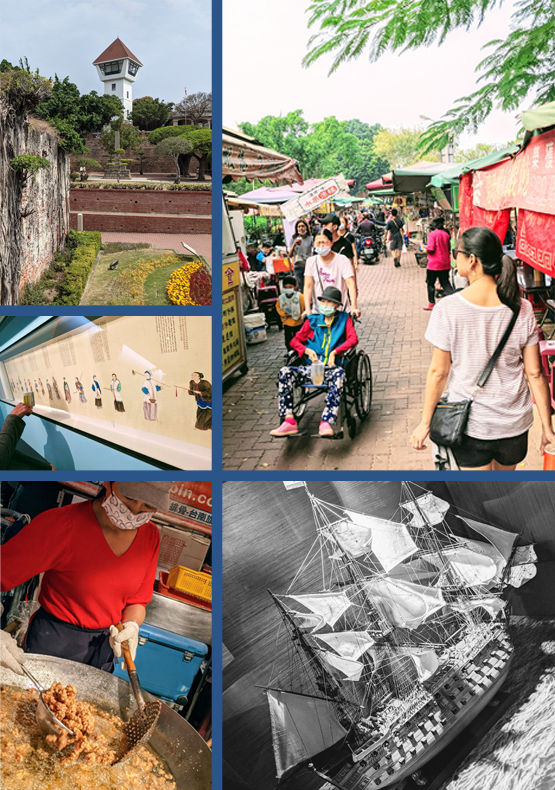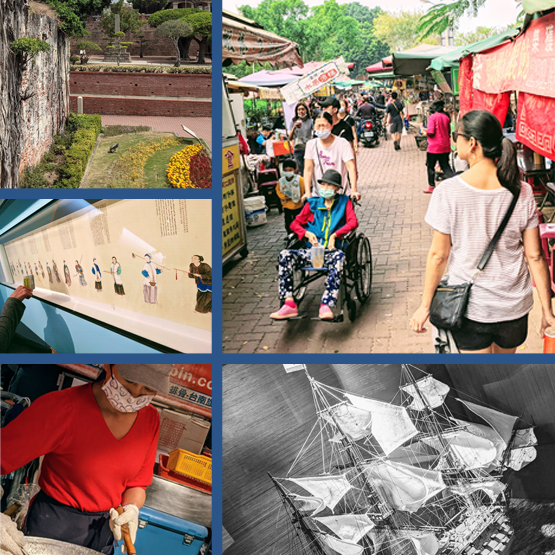Tainan, Taiwan’s “first city,” is home to some of Taiwan’s oldest historical landmarks, including remnants of the Dutch settlement at Fort Zeelandia and Taiwan’s oldest street.
After Koxinga claimed the island from the Dutch colonists in 1661, Tainan served as Taiwan’s “Capital City” for 200 years until 1887 when the Qing dynasty relocated the capital to Taipei.
To really grasp Taiwan of today, it helps to understand its past. A trip to Tainan is an excellent way to immerse yourself in Taiwanese history, to learn a bit more about the historical roots of Taiwanese culture and to sample the many delectable tastes that modern Tainan is famous for.
Getting to Tainan
Tainan is only a short drive north from Kaohsiung. It has an HSR station and, like most stops in Taiwan, will take no more than a 2 hour trip from Taipei. If you have a limited amount of time and can wake up early, it’s possible to do Tainan over the course of a long day trip. But we recommend taking at least 3 days to get a good first impression of all Tainan has to offer. Make no doubt, you will want to come back for more!
Day 1—Taiwanese History
Taiwan Museum of National History

Get an early start and head out to the Taiwan Museum of National History. The museum is about a 20 minute ride outside of downtown, but you will really need the full day to see the exhibits and linger a bit. Of course, not everyone can handle a full day in the museum, but we really can’t recommend this one enough for a couple reasons: First, Tainan’s significance to the Taiwan traveler is that it helps those of us who don’t already know very much about Taiwan’s history to learn the historical and political contexts. The museum does a fantastic job giving its visitors an overview of Taiwan’s main historical periods, from prehistorical times, to the brief European encounters, through the Chinese and Japanese colonial times, explores in-depth the formative years of the Chinese Nationalist occupation, and finally celebrates the emergence of the Taiwanese democracy in the 1990s.
Taiwan is one of the most exciting places on our planet because it is the home of such a new and vibrant democratic government. To really grasp how significant this, you really need to grasp Taiwan’s historical context, and there’s no better place to start that journey than the Taiwan Museum of National History in Tainan.
Tainan Flower Night Market

If you manage to time your stay at the museum to last until evening, a great choice for a stop on your way back to town is to visit Tainan’s Flower Night Market. Also known as the Garden Night Market, it’s one of the famous night markets of all of Taiwan. Describing the three most famous markets on the island, the locals say “South is Flower, Middle is Fengjia, North is Shihlin.” One of the largest night markets in Taiwan, you can find all of the standard nigh market treats and eats, as well as shops and a few games for the kids. As always, a fun and affordable way to satisfy your cravings and an electrifying feast for the senses.
Day 2—Anping Historical District
Fort Zeelandia

After a long day at the museum, you’ve gained a strong overview for Taiwan’s history. Next, you get to put a few places with the names. And with the Dutch settlement at Anping being among the first moments of (recorded) Taiwanese history, what better place to start your day than at Fort Zeelandia, built by the Dutch East India Company between 1624 and 1634, and the seat of Dutch rule on Taiwan for 38 years.The Dutch were led by Martinus Sonck, a lawyer by training who was sent by the Dutch East India Company as an “advocaat-fiscaal” to handle their affairs abroad. The fort took its name from his ship—the Zeelandia—named after Zeeland, the southwestern province of the Netherlands, a territory that was also the eponym for New Zealand.
The grounds of Fort Zeelandia offer a few glimpses of the 400 year old ruins of the old Fort. The majority of the property was rebuilt during Japanese Colonial period. If you make your way to the top of the observation tower you can take in sweeping 360 degree views of Tainan.
Find Anping Old Street, or Yanping Street—running in the immediate vicinity of the Fort—is a must-see as the oldest street in Taiwan. Here you can grab a snack and shop the merchant stalls for a souvenir or two to take home.
Tait & Co. Merchant House & Anping Tree House

After lunch, you can work your way back behind the Fort to the Former Tait & Co. Merchant House, also known as the Anping Tree House. Founded in 1845, Tait & Co—now Tait Marketing and Distribution Co.—primarily engaged in the export of tea and sugar. The Merchant House has been converted to a museum dedicated to Tainan trade in the mid 19th century with additional space for seasonal art exhibits.
The Tree House is located behind the museum, an old abandoned warehouse that has been overrun by banyan trees after decades of dilapidation. The warehouse has been renewed as a nature exhibit, fortified by steel girding and walking paths and newly installed staircases to provide a neat adventure to observe how nature “heals itself” in man’s absence. This is a very kid friendly site that adults will also enjoy.
Day 3—West Central District
Chihkan Tower

Tainan’s West Central District is home to dozens of interesting sights, sounds and flavors. You definitely won’t want to miss out on sampling some of the great flavors Tainan is known for, especially the now world famous turkey rice at Rou Bo. But in keeping with the historical theme of your trip to Tainan, there are a few destinations you must not miss.
First stop, find Chihkan Tower on the former site of Fort Provintia, the inland Dutch outpost. Built about 2 miles east of Fort Zeelandia in 1653, the Dutch intended the site to strengthen their standing during their short-lived colonization of Taiwan. But it made itself an easy target for Koxinga, who allied with native Taiwanese and took Fort Provintia in four days of fighting during the epic battle now known as the Siege of Fort Zeelandia. Koxinga, a Ming loyalist and founding father of the ancient capital Tainan, took over Fort Provintia and turned it into the administrative headquarters for the southern Ming regime’s eastern capital. The original Fort was later destroyed in an earthquake in the 19th century, but was later rebuilt as Chihkan Tower, where it continued to serve as Taiwan’s capital during the later Qing dynasty.
House of Koxinga
Koxinga and his heirs continued to rule in southwestern Taiwan from 1661 to 1683 under what is now known as the Kingdom of Tungning or Kingdom of Formosa.

The Koxinga dynasty intended to use Taiwan as a headquarters to restore Ming rule in China after overthrow by the Manchu-led Qing dynasty. During this period, the House of Koxinga rulers instituted a Ming-style administration, the first Chinese governance in Taiwan. In 1665, Koxinga’s son Zheng Jing and Chief of General Staff Chen Yonghua oversaw the building of Tainan Confucian Temple. Renovated many times since, the temple sits adjacent to the Koxinga Shrine and Koxinga Museum, all situated on a beautifully maintained property. This is a quiet place to spend an afternoon and learn more about Koxinga as well as the Confucian contributions to Taiwanese culture.
Shennong Street

By evening, make your way to Shennong Street, which was the original entrance to the Tainan Five Channels area. Now covered by roads, the channels were the important water ways leading to Tainan’s inland river port during the Qing dynasty. As all merhcants bringing goods to Taiwan would enter through these ports, Shennong Street was the busiest street of its time. Today, it is home to a few restaurants and lots of cute shops stocking goods made by local craftspeople. It’s noteworthy for its colorful decor, with nearly all shopkeepers sporting traditional style lanterns to attract guests. Although the shopping is better when more stores are open in the daytime, you definitely want to schedule a visit by night to enjoy the lights!
Plus
Must Try Foods During Your Stay In Tainan
- Turkey Rice
- Coffin Bread
- Oyster Omelet
- Danzai Noodles
Other Noteworthy Stops
- Taijiang National Park
- Tainan Grand Mazu Temple
- Tainan Art Museum Building 1 (for modern arts)
- Museum of Archaeology, Tainan Branch of National Museum of Prehistory
- Hayashi Department Store
What to Skip
Chimei Museum is usually ranked high on Tainan lists of things to do, but unless you have a specific reason to do so (you play violin, for example) we recommend you make this a low priority. After all, you didn’t make your way all the way to Tainan so you could browse a Western art collection, right?



While the Mediterranean climate characterizes most of the country, there are two other climate systems that are present. One is the cool Alpine climate which is found on mountainous areas of the country’s interior, including many high-altitude valleys.